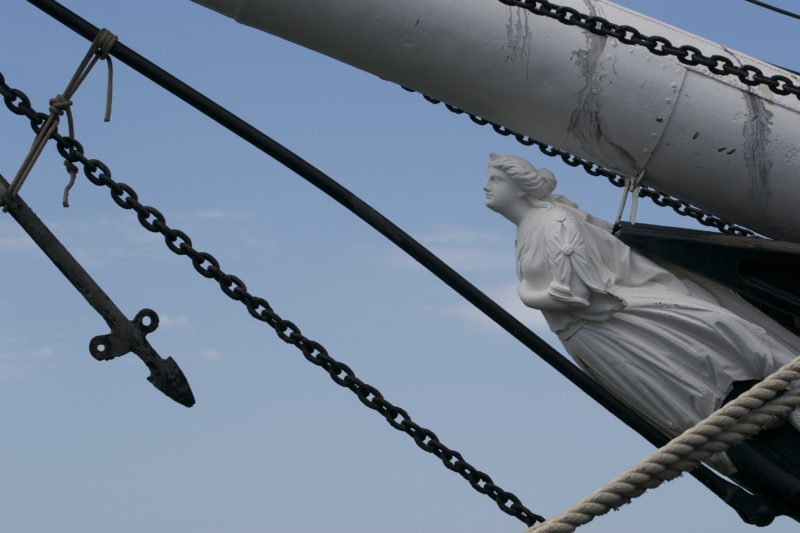
There are two categories of Dutch movies: one kind is populated with a lot of nasty Nazis and the other is swarming with patriotic colonialists sailing the seven seas, their Vermeer-modeling wholesome families enduring their absence. I will report on the latter category, since I had a blast streaming The Admiral. Nothing more comforting than sitting on your sofa, eating salty licorice (a Dutch specialty, an acquired taste) and watching sea battles from hell, in glorious re-enactment and/or animation, between little David Holland and the evil Goliath(s) of Britain, Germany and France. David is winning one battle after another against the giants, with the help of Michiel de Ruyter, sailor supreme.
Admiral de Ruyter is a celebrated historical figure in Holland, taught about in every child’s history class, presented in museums, biographies about him filling whole library shelves. He lived in interesting times, the 17th century, at the brink of civil war between the Republicans and the Orangists, in a small country challenged by hostile external forces trying to cut a bigger slice of the mercantile pie called colonies and West Indies trade. The Republicans re-structured and re-financed his navy, his naval successes supporting their power position in turn, up to a point. Whether he was a political figure or just interested in patriotic duty for his fatherland remains in dispute. Fact is he was both a brilliant strategist and a tactician when it came to warfare and extremely successful in luring much larger naval powers into traps.



When the movie opened in Holland in 2015 there was loud and vigorous protest from the left, because de Ruyter’s reconquest of slave stations from the West Indies Company in West Africa – not even mentioned in the movie – was seen as evidence for the man’s ardent pro-slavery ideology – and thus his celebration in the movie condemned.

British naval history buffs have other problems with the film: listing each and every detail gone wrong in the historical enactment, pages of them, and speculating that the film had no English subtitles (it does now) because they were the bad guys. https://jddavies.com/2015/05/11/the-film-and-the-facts-about-the-movie-michiel-de-ruyter/

I’m sure life was hard on these ships, the conditions – starvation, scurvy, diseases, the danger, the uncertainty. Never mind war. But at least men had a choice, they could stay on land or go on board – women didn’t. How could you even communicate after two years’s absence, returning from Batavia, whole worlds in your head unimaginable to those left at home? I’d ask him that.
This is a portrait of Michiel de Ruyter by Ferdinand Bol from the Rijksmuseum.
Here is the trailer:https://www.youtube.com/watch?v=j21t1i_SiKI



Steve Tilden
I know more than most, I tjhink, of what it was like to sail those ships. I crewed on a barkentine rig when I was home from college in Hawaii. It was 75 feet long, a fore-mast, a main-mast, and a mizzen-mast, four squaresails on the fore-mast, from top down the royal, t-gallant, top-sle, and course. We had to know all the lines to rapidly unfurl and set them when the wind was favorable.
The main-sle and the mizzen were gaff rigged, a smaller boom above the main boom. NO WINCHES. NO BLOCK AND TACKLE. Every sail set with ‘Swedish Steam’ (muscle and sweat). Sweating Hooks were by the belaying pin racks, and one man pulled the hawser lifting the throat of the gaff while a second man hooked the hawser under a sweating hook and then around a belaying pin (belaying pins all had names according to their size, the largest called the commander). then while man #2 held the hawser tight, the first pulled it sideways, like pulling the tight string of a guitar with your finger. The second man then took up the small bit of slack that created, over and over again until the hawser and the throat of the sail above was tight. This was repeated for the other end of the gaff. If the jib sheet was not tight enough, the skipper would come into the wind until the jib luffed, two men would haul it tighter around the cleat and make it off, then the3 skipper would falls off and take the wind just right.
This ship, named the California, was built sometime in the 30’s for a couple of engineers, who sailed her down to Panama to work on the canal. Then they sailed her around the world. Definitely wooden ship, and we were more aluminum men than iron, but we got the idea.
Lee Musgrave
Love the montage… are the figures from a Bosch or a Bruegel?
Pieter Bruegel is my favorite artist from Art History. Have you read the book As Above So Below? It’s a fictional account of his life.
friderikeheuer@gmail.com
The heads are from a church painting in the Grotekerk Alkmaar – I have to dig out who did them, but nobody who I recognized. Have not read the book – onto the library list!